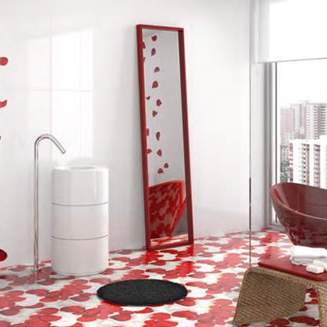Tile for the bathroom - universal material for the improvement of this room, which helps to implement various fantasies and protect the walls from the harmful effects of moisture.
Content
Today we will tell you how to choose a tile for lining walls and floor in the bathroom.
Advantages of using tiles:
- is an eco-friendly;
- has low electrical conductivity;
- she is not terrible bacteria;
- has a variety of design and texture;
- it is easy to care for her, etc.
Types of ceramic tile
Two types of tiled material are distinguished:
1. Wall-mounted - designed to finish the walls in the bathroom. Thanks to a pretty soft structure, it perfectly cuts out that it provides a wonderful opportunity to customize products when installing plumbing.
2. Outdoor - resistant to abrasion, characterized by a small degree of water absorption, has a denser structure.
Today there are five classes of outdoor tiles:
- first class - applied indoors where small permeability is present and shoes are not used;
- the second class is used in the premises where there is not a very big density of movement (apartments, cottages);
- the third class - such a tile is made by floor cladding, which does not have access from the street;
- the fourth grade is used to finish the floor in general-purpose buildings;
- fifth class - used for lining of various types of rooms.
Thus, the difference between the floor tiles from the one that is created for lining of the walls is as follows:
- it is inert to the effects of chemical media;
- designed for large friction loads;
- has excellent pressure resistance and shocks;
- more wear-resistant and durable;
- thickness 9-12 mm.
Tile species that are classified by type and method of manufacture:
- Clinker - tile, which is obtained by mixing high-quality materials with coloring substances and clay by extrusion. Such products have a varied geometric shape, resistant to temperature differences and do not require special care.
- Beacotture is an enameled tile that has been subjected to double burning and past the presses. In this case, the material has low strength and is used as small decor elements.
- Monocotture is an enameled tile that has been subjected to one-time burning and past the press. It has excellent wear resistance and durability, can be used for gender improvement and walls.
- Monoporosis - a tile that was subjected to a single clamp, past the press and covered with a special icing. It is used for an additional decor and installed with extreme caution.
Tile design in bathroom
When choosing a tile, the consumer is almost always guided by personal preferences, however
Today you can identify general trends that offer the most successful design using this material. So, for example, a classic version in which the advantage is given to the pastel colors, never comes out of fashion and does not bother for a long time. On the same, there are bright shades of orange, green or yellow, which actively act on the psyche and annoy perception.
As for the size, the large tile, supplemented with a pattern with repeating elements, is wonderful in a large bathroom. In addition, it is capable of visually increasing the space, so it is sometimes used in the rooms of the midline. Little tile is well combined with other building materials in spacious or medium-sized bathrooms. For small rooms, it is best to use medium-sized products.
Choosing a tile for the bathroom
Regardless of which technology and from which building materials, a tile was produced, it should have the following characteristics:
- comply with environmental standards;
- have chemical resistance class AA;
- enter water absorption from 7% -20%.
The characteristics to be paid attention to the process of acquiring tiles:
- Tile drawing should have good quality - uniform brightness and color saturation.
- The tile must have a reduced level of moisture absorption.
- By choosing a tile, pay special attention to its porosity from the reverse side. If the surface has a small amount of pore, then the product will absorb less water.
- The back side should be smooth, not to have depressions, convexities and irregularities.
- The product should be resistant to chemical exposure.
- The material must be tolerant to the temperature differences and steam effects.
- The class of the tile must match its intended purpose.
As for the flooring, another number of requirements are added to it:
- it should not be subject to abrasive substances;
- have resistance to bend;
- have a durable surface, not susceptible to abrasion.
Best Ceramic Tile Manufacturers
Spanish tile - products, for the production of which is used white and red clay. In this country, various types of products are manufactured, ranging from a terrace and outdoor tile and ending with wall tiles. Best factories: Novogres, Tilegres, Aparisi, Ceramica, Saloni, Pamesa, Cabrara.
The Turkish tile has long gained tremendous popularity worldwide, with more than 50% of the total production of Kalebodur factories. When it is created, a white clay is used, which is characterized by high quality and availability.
Lithuanian production tile is distinguished by frost resistance and wear resistance. She is manufactured by the company "Dwarce Ceramics". At the same time, the factory creates several types of products intended for residential and technical premises, as well as workshops.
As for the ceramic tile produced in Slovakia, it features an exclusive design and durability. The famous GRES factory supplies fairly low-cost products that is available to our consumer.
Tile for bathroom photo:
How to choose a bathroom tile video:


































